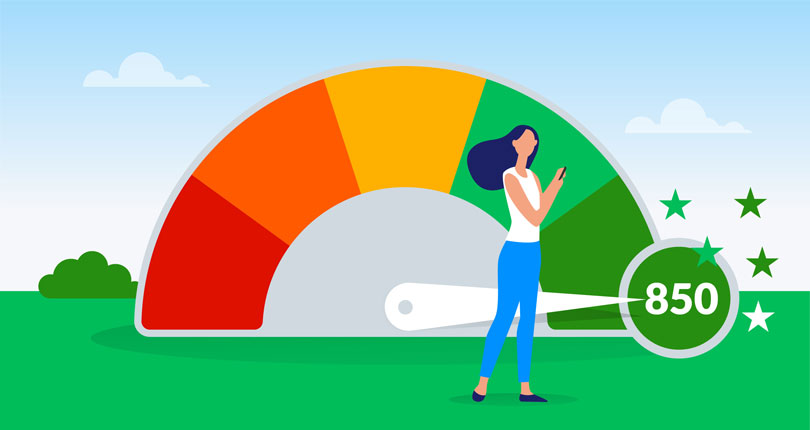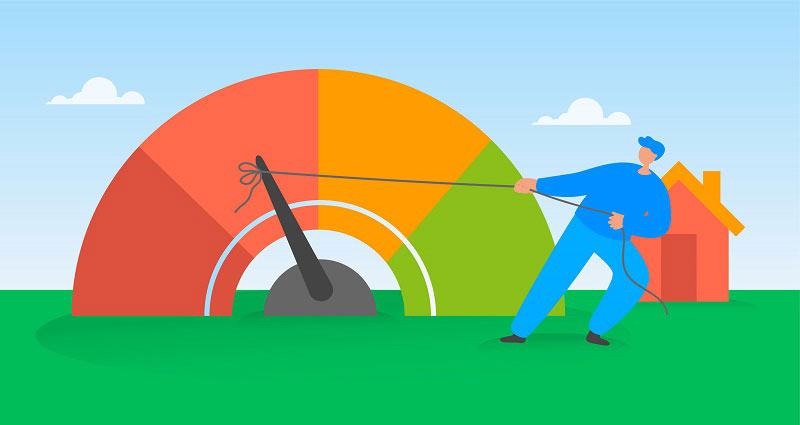
The average Vantage credit score in New York is 699. When most people think of the Empire State, they think of New York City. While that’s understandable, New York is a state that’s far more diverse than the Big Apple. The ways in which it handles debt are just as varied. In this article, we’ll look at the variety of economic circumstances that make up the New York credit landscape.
Key statistics
- New York’s average VantageScore is 699. The national average is 690.
- The median income of New York ($72,108) is more than $6,000 above the national average ($65,712).
- New York is ranked 8th among the top ten states with credit card delinquencies of 90 days or more. New York’s delinquency rate is just above 8 percent. Nevada is ranked first at 11 percent.
- Students in New York receive the second highest amount of total grant aid in the country. New York also ranks first for aid awarded based on financial need. In the 2015-2016 academic year, New York awarded $956 million in need-based grants, and $11.3 million in need-based financial aid. [13] NASSGAP - 47th Annual Survey Report on State-Sponsored Student Financial Aid https://www.nassgapsurvey.com/survey_reports/2015-2016-47th.pdf New York’s average borrower debt is $30,931. The national average is $32,731. [14] Average Student Loan Debt in America: 2019 Facts & Figures https://www.valuepenguin.com/average-student-loan-debt
New York’s Credit Score Over Time
| Year | Average Vantage Score - NY |
|---|---|
| 2015 | 681 |
| 2016 | 735 |
| 2017 | 659 |
| 2018 | 692 |
| 2019 | 694 |
| 2020 | 699 |

How to Build Credit When You Have None
Building credit from scratch can be a lot easier when you understand where to start and which mistakes to avoid.
Download our guideHow Credit Scores in New York Compare to Other States
| Year | Average Vantage Score - NY | Average Vantage Score - US |
|---|---|---|
| 2015 | 681 | 672 |
| 2016 | 735 | 726 |
| 2017 | 659 | 678 |
| 2018 | 692 | 678 |
| 2019 | 694 | 684 |
| 2020 | 699 | 690 |
When looking at New York’s average credit scores compared to the rest of the country, it appears that the way New York handles debt is not that different from the country as a whole. However, once you dig deeper into the specifics, the meeting of these two trend lines reveal a much different picture, especially when it comes to the types of debt, the amount of debt, and the circumstances behind those numbers.
Along with New Jersey and Pennsylvania, New York is tied for eleventh highest average Vantage scores. All three states have an average Vantage score of 699, which is within the “good” range of 658-719. It seems that, while the amount of debt New Yorkers carry varies widely, they manage it fairly well on average, as we’ll soon see.
Debt in New York
| Year | Average Household Debt - NY | Average Household Debt - US |
|---|---|---|
| 2003 | $31,250 | $33,430 |
| 2004 | $35,260 | $37,290 |
| 2005 | $38,780 | $40,650 |
| 2006 | $43,380 | $45,410 |
| 2007 | $48,030 | $50,170 |
| 2008 | $49,530 | $52,010 |
| 2009 | $48,710 | $49,820 |
| 2010 | $47,720 | $47,410 |
| 2011 | $48,990 | $47,790 |
| 2012 | $48,900 | $47,020 |
| 2013 | $47,360 | $45,310 |
| 2014 | $47,220 | $45,710 |
| 2015 | $46,930 | $46,000 |
| 2016 | $47,760 | $46,950 |
| 2017 | $49,030 | $48,800 |
| 2018 | $49,680 | $50,090 |
| 2019 | $51,280 | $51,580 |
Although the average total household debt in the United States had been steadily climbing since 2015, it began to decline in the first two quarters of 2020. [1] Credit card debt plunges, driving a decline in overall household debt. https://www.nytimes.com/2020/08/06/business/credit-card-debt-plunges-driving-a-decline-in-overall-household-debt.html That’s significant, because that decline is occurring during a pandemic when the country as a whole has seen massive unemployment. New York closely follows this trend. However, when we break down the debt New Yorkers carry into its respective categories, we see that their debt management performance is better in some areas than in others.
Mortgage Debt
| Year | Average Mortgage Debt - NY | Average Mortgage Debt - US |
|---|---|---|
| 2003 | $21,350 | $23,740 |
| 2004 | $24,050 | $26,590 |
| 2005 | $26,400 | $29,230 |
| 2006 | $30,290 | $33,400 |
| 2007 | $34,380 | $37,250 |
| 2008 | $35,320 | $38,490 |
| 2009 | $34,610 | $36,810 |
| 2010 | $33,970 | $35,010 |
| 2011 | $33,770 | $34,200 |
| 2012 | $33,570 | $33,230 |
| 2013 | $32,170 | $31,630 |
| 2014 | $31,830 | $31,520 |
| 2015 | $31,240 | $31,330 |
| 2016 | $31,490 | $31,590 |
| 2017 | $32,380 | $32,940 |
| 2018 | $32,620 | $33,680 |
| 2019 | $34,030 | $34,790 |
In recent years, the average mortgage debt for New York generally tracked the national average, but that wasn’t always the case. In the early 2000s, home mortgage debt for some of the most expensive real estate in the country (New York City, the Hamptons, Westchester County, Great Neck, Nyack, etc. [2] The 10 Most Expensive Places To Live In New York For 2021 https://www.homesnacks.com/most-expensive-cities-in-new-york/) was actually below the national average. A median income of more than $7,000 over the national average will certainly help residents stay current with mortgage payments. [8] New York Household Income https://www.deptofnumbers.com/income/new-york/
However, like most of the world, New York did not count on COVID-19. While New York’s average mortgage debt has seen its ups and downs, in 2015 it began a slow, steady climb. Then the COVID-19 pandemic exacerbated a problem that New York had been battling since before the pandemic started: a very high delinquency rate.
Even with Governor Andrew Cuomo instituting a moratorium on mortgage payments in March 2020 [3] New York Suspends Mortgage Payments For Those Facing Financial Hardship https://www.forbes.com/sites/zackfriedman/2020/03/19/mortgages-coronavirus/?sh=302d6c421df4 and the CARES Act declaring a moratorium on foreclosures, the state of New York still has the highest rate in the nation of mortgage payments that are 90 days or more past due. [4] New York State Has the Highest Rate of Seriously Delinquent Mortgage Debt in the U.S. https://geneseesun.com/new-york-state-has-the-highest-rate-of-seriously-delinquent-mortgage-debt-in-the-u-s/ While this is currently the highest delinquency rate in the country at 1.9 percent, it actually used to be higher. Following the Financial Crisis and subsequent Great Recession in 2008, New York’s delinquency rate fluctuated between 9 and 10 percent between 2009 and 2011. [5] Household Debt Statistics by State (1999-2019) - Federal Reserve Bank of New York https://www.newyorkfed.org/medialibrary/interactives/householdcredit/data/xls/area_report_by_year.xlsx
Credit Card Debt
| Year | Average Credit Card Debt - NY | Average Credit Card Debt - US |
|---|---|---|
| 2003 | $3,490 | $2,960 |
| 2004 | $3,570 | $3,040 |
| 2005 | $3,660 | $3,060 |
| 2006 | $3,730 | $3,170 |
| 2007 | $4,020 | $3,490 |
| 2008 | $4,150 | $3,670 |
| 2009 | $3,820 | $3,370 |
| 2010 | $3,510 | $3,050 |
| 2011 | $3,440 | $2,950 |
| 2012 | $3,390 | $2,850 |
| 2013 | $3,250 | $2,710 |
| 2014 | $3,270 | $2,730 |
| 2015 | $3,380 | $2,800 |
| 2016 | $3,520 | $2,930 |
| 2017 | $3,710 | $3,100 |
| 2018 | $3,840 | $3,220 |
| 2019 | $4,010 | $3,390 |
It’s hard to get a good credit score without carrying credit card debt, and New Yorkers carry a lot of credit card debt. In 2017, the total credit card debt in New York state totaled $58.2 billion, which was the fourth highest total debt amount among the fifty states. [6] Credit Card Debt in New York State https://www.osc.state.ny.us/files/reports/special-topics/pdf/economic-credit-card-debt-2018.pdf Average credit card debt for New Yorkers has remained significantly above the national average for more than a decade. From 2008 through 2013, the state’s average credit card debt declined, largely due to the Great Recession. Yet once the economy began to rebound in 2014, so did New Yorkers’ appetite for purchasing power, and credit card debt started to steadily climb again.
New York has a similar problem with credit card delinquencies, just as with mortgage delinquencies. New York ranks 8th among the top ten states with credit card delinquencies of 90 days or more. [6] Credit Card Debt in New York State https://www.osc.state.ny.us/files/reports/special-topics/pdf/economic-credit-card-debt-2018.pdf New York had a ten-year period from 2006 to 2016 where delinquencies steadily declined, but that trend ended and the curve inched upward in mid-2016. Interestingly, delinquencies nationwide have been down in 2020 due at least in part to lenders’ consumer accommodations made through the CARES Act. [7] Consumer Delinquencies Slow During Pandemic https://www.experian.com/blogs/ask-experian/research/consumer-delinquencies-slow-during-pandemic/
An interesting facet of New York’s delinquency rate can be illustrated when the rate is broken down by region. For example, Ithaca has the state’s lowest average credit card balance at $4,300. It also has a very low 90+ day delinquency rate of 5.3 percent. Staten Island with a high average balance of $6,300 has a high delinquency rate of 8.8 percent. Yet the Bronx, the borough with the state’s highest delinquency rate of 15 percent, has one of the lowest average balances of $4,600.[6]
Unfortunately, the CARES Act is a temporary measure, and the effects of future forbearance measures remain to be seen. New York did see a 1.8% decrease in 30-day delinquencies during 2020. It was one of the states hit hardest and earliest by the pandemic, so the effects on New York’s economy can be used as a predictor for other cities where the pandemic hit hardest later in the year.
Auto Loan Debt
| Year | Average Auto Loan Debt - NY | Average Auto Loan Debt - US |
|---|---|---|
| 2003 | $2,410 | $2,960 |
| 2004 | $2,570 | $3,040 |
| 2005 | $2,850 | $3,240 |
| 2006 | $2,930 | $3,360 |
| 2007 | $2,710 | $3,360 |
| 2008 | $2,630 | $3,310 |
| 2009 | $2,540 | $3,030 |
| 2010 | $2,610 | $2,950 |
| 2011 | $2,740 | $3,050 |
| 2012 | $2,870 | $3,270 |
| 2013 | $2,930 | $3,420 |
| 2014 | $3,110 | $3,720 |
| 2015 | $3,350 | $4,070 |
| 2016 | $3,470 | $4,340 |
| 2017 | $3,560 | $4,520 |
| 2018 | $3,700 | $4,700 |
| 2019 | $3,780 | $4,850 |
America’s love of the automobile has been well-documented. Of all the capital investment in transportation in the US since 1956, 78 percent was spent on highways. The remaining amounts were divided between rail, aviation, mass transit (such as subways and trolleys) and water. [9] Driving into Debt https://uspirg.org/feature/usp/driving-debt
With the cost of automobiles rising and auto loans increasing in length, American consumers seem locked into a never-ending cycle of auto debt. New York, however, has been taking steps to help consumers in this area. Last May, New York’s attorney general Letitia James, along with other attorneys general from around the country, reached a settlement with Santander Bank to provide consumer relief for unfair lending practices. Santander targeted subprime borrowers, putting them into loans with a high probability of default. [10] Attorney General James Announces Over $550 Million Settlement with Nation’s Largest Subprime Auto Financing Company, Delivering Relief to Hundreds of Thousands of Struggling Consumers https://ag.ny.gov/press-release/2020/attorney-general-james-announces-over-550-million-settlement-nations-largest The settlement will repair borrowers’ credit scores and require subprime lenders to stop writing loans that they know a consumer cannot repay.
While New York’s amount of auto debt is steadily increasing, it still falls below the national average. A big contributor to this is New York City, which is arguably the most transit-oriented city in the United States.[9] If you have ever been stuck in traffic at either the Lincoln or Holland Tunnels, the George Washington Bridge, or the Long Island Expressway, then you have probably entertained the thought, “I should have taken the train.” You can visit any of the five boroughs on the confusing but relatively reliable subway system. If you add the Long Island Rail Road and the bus, you can go from the Hamptons to the far end of the Bronx without ever using a car.
Student Loan Debt
| Year | Student Loan Debt - NY | Student Loan Debt - US |
|---|---|---|
| 2003 | $2,410 | $1,060 |
| 2004 | $2,570 | $1,440 |
| 2005 | $2,850 | $1,610 |
| 2006 | $2,930 | $1,970 |
| 2007 | $2,710 | $2,250 |
| 2008 | $2,630 | $2,670 |
| 2009 | $2,540 | $3,010 |
| 2010 | $2,610 | $3,370 |
| 2011 | $2,740 | $3,620 |
| 2012 | $2,870 | $4,000 |
| 2013 | $2,930 | $4,250 |
| 2014 | $3,110 | $4,490 |
| 2015 | $3,350 | $4,660 |
| 2016 | $3,470 | $4,920 |
| 2017 | $3,560 | $5,130 |
| 2018 | $3,700 | $5,390 |
| 2019 | $3,780 | $5,510 |
There are more than 300 colleges and universities located in New York. California is the only state with more higher education institutions. [11] A Deeper Look at Student Loan Debt in New York State https://rockinst.org/blog/a-deeper-look-at-student-loan-debt-in-new-york-state/ These institutions serve about 1.2 million students at any given time, and 59 percent of those students will graduate with debt. [12] New York students owe over $31,000 in college debt, report finds https://www.silive.com/news/2019/09/new-york-students-owe-over-31000-in-college-debt-report-finds.html While this number seems sobering, it’s important to note the flip side of this coin; namely, that more than 40 percent of students will graduate with no debt at all.
New York turned a corner with regard to student debt in 2008, the year that New York’s average student loan debt dropped below the national average. It’s stayed there ever since, and there are a few reasons for this. First and foremost, the State University of New York (SUNY) is the largest comprehensive system of public universities, colleges, and community colleges in the country. [12] New York students owe over $31,000 in college debt, report finds https://www.silive.com/news/2019/09/new-york-students-owe-over-31000-in-college-debt-report-finds.html SUNY serves 400,000 students, half of whom will graduate without any debt. The other half will carry debt of about $26,000 for a bachelor's degree, a manageable sum.
New York higher education has kept the burden of debt for students lower than other states by keeping tuition reasonable and offering a wide range of financial assistance, and even tuition reimbursement in many cases. New York ranks second in the nation for the most total grant aid awarded to students and ranks first for aid awarded based on financial need. [11] A Deeper Look at Student Loan Debt in New York State https://rockinst.org/blog/a-deeper-look-at-student-loan-debt-in-new-york-state/
Sources
- [1] Credit card debt plunges, driving a decline in overall household debt. https://www.nytimes.com/2020/08/06/business/credit-card-debt-plunges-driving-a-decline-in-overall-household-debt.html
- [2] The 10 Most Expensive Places To Live In New York For 2021 https://www.homesnacks.com/most-expensive-cities-in-new-york/
- [3] New York Suspends Mortgage Payments For Those Facing Financial Hardship https://www.forbes.com/sites/zackfriedman/2020/03/19/mortgages-coronavirus/?sh=302d6c421df4
- [4] New York State Has the Highest Rate of Seriously Delinquent Mortgage Debt in the U.S. https://geneseesun.com/new-york-state-has-the-highest-rate-of-seriously-delinquent-mortgage-debt-in-the-u-s/
- [5] Household Debt Statistics by State (1999-2019) - Federal Reserve Bank of New York https://www.newyorkfed.org/medialibrary/interactives/householdcredit/data/xls/area_report_by_year.xlsx
- [6] Credit Card Debt in New York State https://www.osc.state.ny.us/files/reports/special-topics/pdf/economic-credit-card-debt-2018.pdf
- [7] Consumer Delinquencies Slow During Pandemic https://www.experian.com/blogs/ask-experian/research/consumer-delinquencies-slow-during-pandemic/
- [8] New York Household Income https://www.deptofnumbers.com/income/new-york/
- [9] Driving into Debt https://uspirg.org/feature/usp/driving-debt
- [10] Attorney General James Announces Over $550 Million Settlement with Nation’s Largest Subprime Auto Financing Company, Delivering Relief to Hundreds of Thousands of Struggling Consumers https://ag.ny.gov/press-release/2020/attorney-general-james-announces-over-550-million-settlement-nations-largest
- [11] A Deeper Look at Student Loan Debt in New York State https://rockinst.org/blog/a-deeper-look-at-student-loan-debt-in-new-york-state/
- [12] New York students owe over $31,000 in college debt, report finds https://www.silive.com/news/2019/09/new-york-students-owe-over-31000-in-college-debt-report-finds.html
- [13] NASSGAP - 47th Annual Survey Report on State-Sponsored Student Financial Aid https://www.nassgapsurvey.com/survey_reports/2015-2016-47th.pdf
- [14] Average Student Loan Debt in America: 2019 Facts & Figures https://www.valuepenguin.com/average-student-loan-debt






